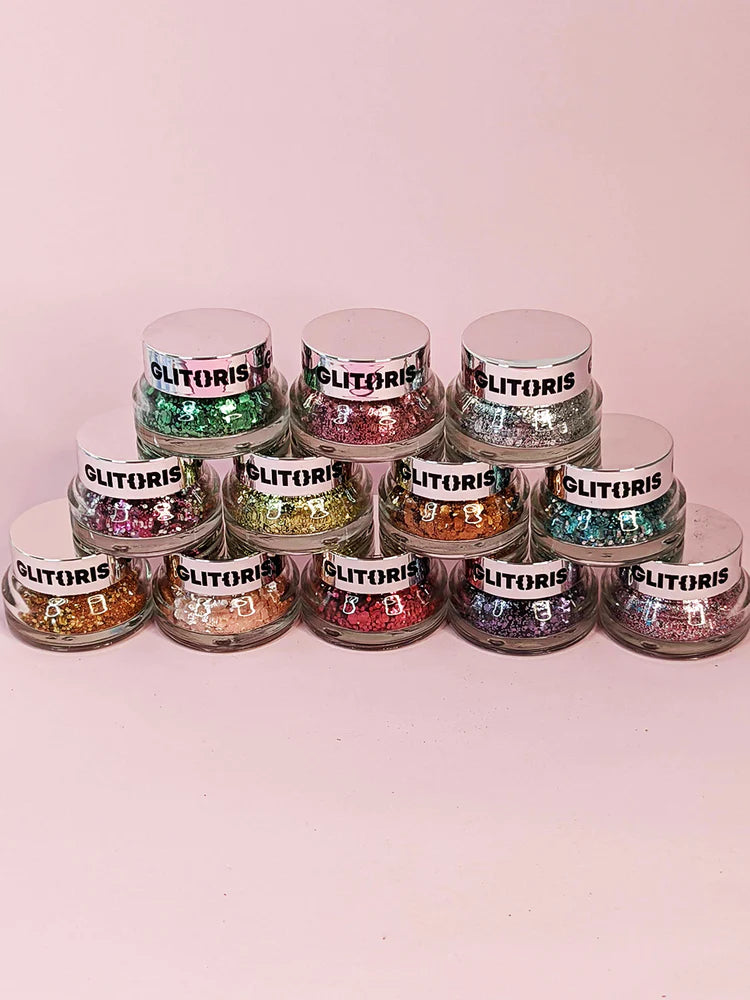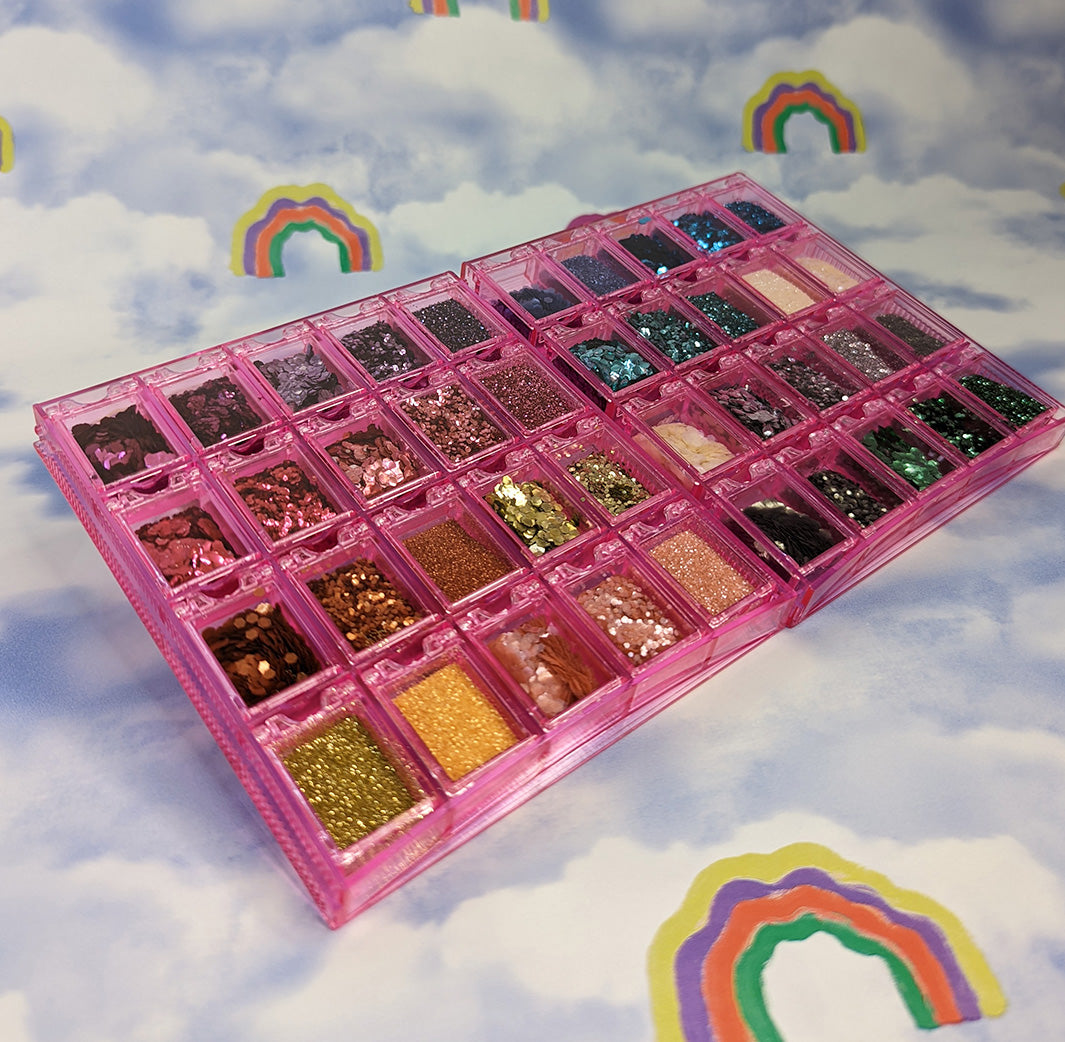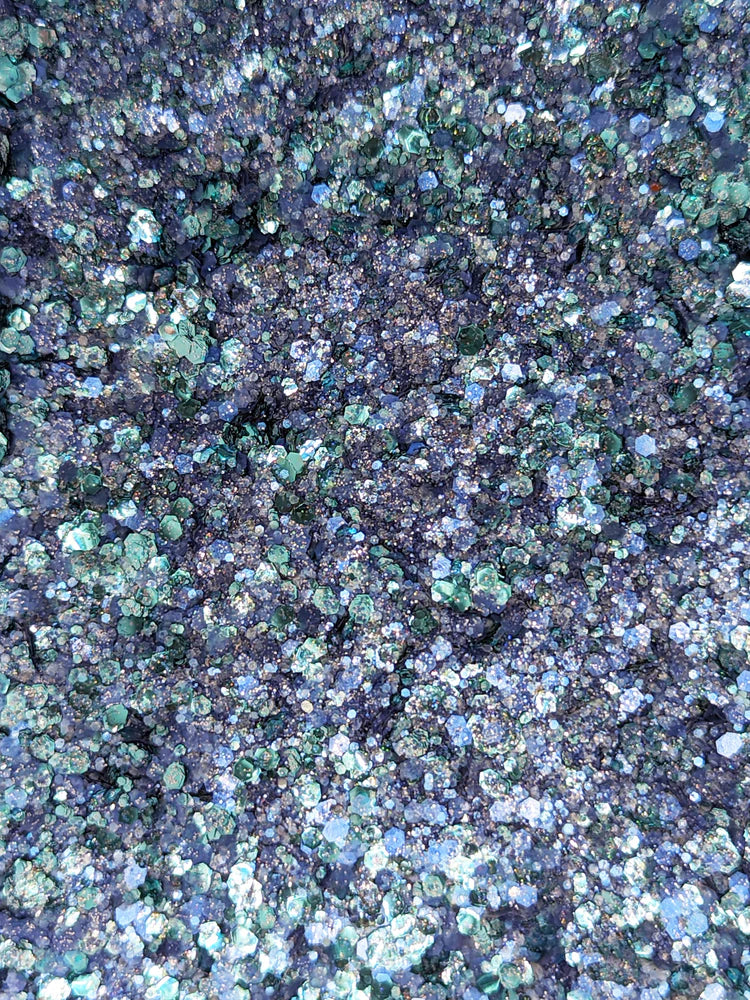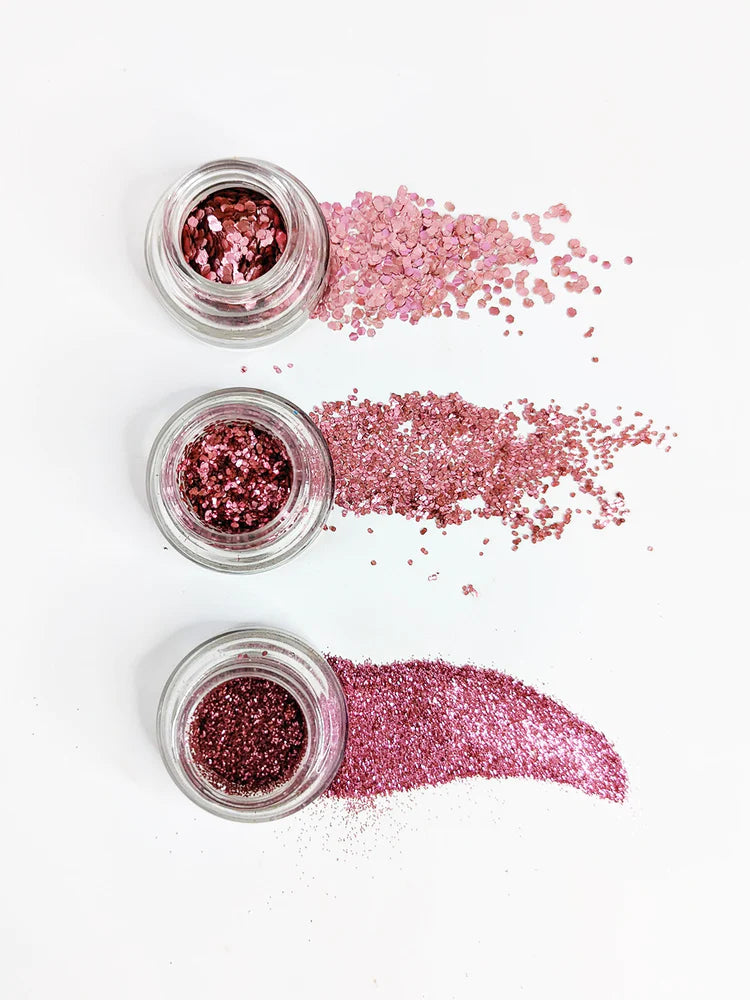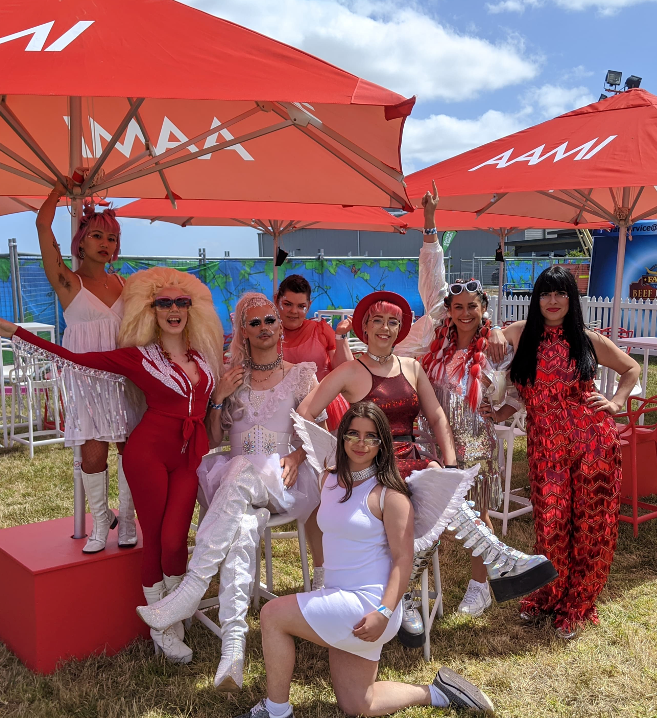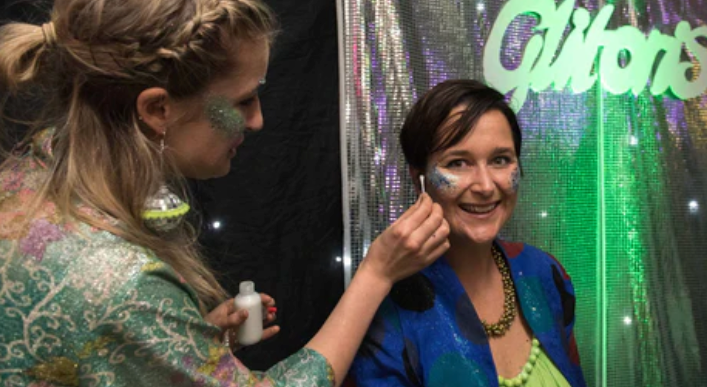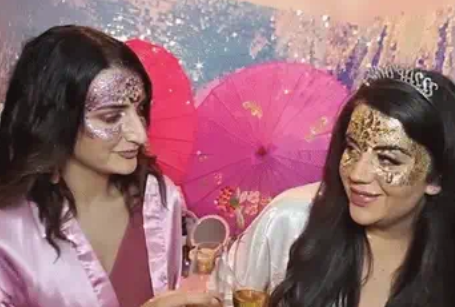A Short History of Glitter – Know your Glitstory.

We've always loved to ✨sparkle✨.
Glittery minerals and pigments have been used in cultures all over the world. For like, well ages. The Ancient Egyptians crushed up beetles in order to make cosmetics that shone and shimmered. #GORGEOUS. Cleopatra, our queen of all queens👸🏿, beauty secret was to use these beetles to get the PERFECT shade of rogue for her pout 👄 .
In Murcia in Southern Spain Nethderthals were known to get dolled up (most likely for a cheeky tapas dinner date) using body paint. Scientists found shells containing pigment residues with reflective minerals – evidence that Neanderthals wore body paint over 50,000 years ago.
I dunno about you, but nothing fills me with more delight than imagining Harry from “Harry and the Hendersons” with a cute glitter cheek.

Shimmering across the ocean were the Mayans – the first people to use teeny-tiny-shiny mica flakes. They pimped the Ancient Mayan temples with lustrous pigments making the sixth century A.D. buildings dazzle in the daylight
Like a moth to a flame🔥, it seems that humans have always been drawn to the glittery and the fabulous – using sparkly pigments in adornment, cosmetics, ritual, protest and in celebration. In this article we take a closer look at this ever-so-important glit-story. 👊
From garbage 🗑️ to glitter.
In 1934 in New Jersey Henry Rushman stumbled across the modern day plastic glitter. He invented this glit from trash. Gliterally. Henry was the OG dumpster diver. One faithful “crafternoon” Henry discovered that by repurposing materials from landfills and by cutting them into very small pieces he could make this very cool glitzy substance. Modern day glitter was born✨✨! Originally this by product had no real use, but he knew he was onto something (moths to a flame people!) So like all great inventors of the 1930’s founded a company - Meadowbank Inventions. Meadowbank still exists today as the largest producer of glitter in the world.
It wasn’t long before the demand for this glitter skyrocketed and plastic glitter became a “necessity.” It is no surprise that Christmas celebrations fuelled the initial sales of Glitter in the 40's and into the 50's. During World War 2, candles and neon lights were banned. Even the torch of the Statue of Liberty was turned OFF. In 1942 the first mention of plastic glitter can be traced to an article in the Times Instead of the traditional Christmas candles it suggested to cover your evergreen tree with glitter over the winter holidays, claiming there would be “additional scintillation” if sprinkled with dime-store glitter.” Glitter came through to help people celebrate.
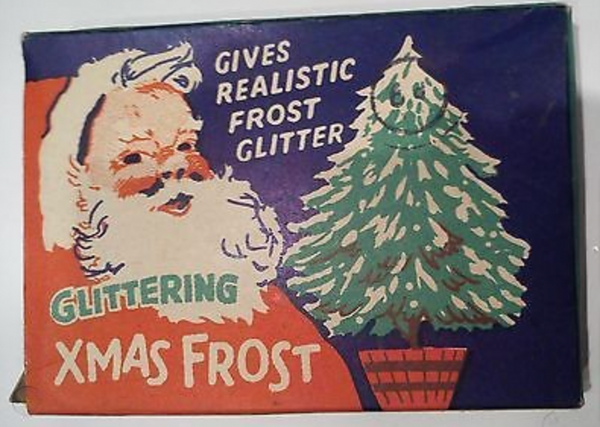
Image: The saviour of Christmas in the 1940's the Xmas Frost Box
Sparkly poops 💩, germs 🦠+ solving murder mysteries 🗡️.
Since the 40’s the uses of glitter have become wider and more varied. We often expect for glitter to be used in craft projects, paints, décor and design. But we are absolutely delighted at the more obscure uses. Uses like mixing glitter with animal feed so researchers can track animals via their💩 sparkly droppings. Or for scientists or school teachers using glit to visualise the spread of germs in a school. Or even to help forensic police to solve murder investigations.
Like our prehistoric ancestors we respond most strongly to glitter when it's used as adornment (AKA faaaaaarshhhunnn) and cosmetics – painting our nails, faces, hair and bodies in it to shimmer and shine. (I mean Glitoris has made a whole biz out of just this.) Almost every cosmetic today has a “shine element” whether it is the sheen in your lipgloss, the dewy finish of your bronzer, the diamante dazzle on your nail, or the glint in your highlighter.
The glittery glamorous divas, gender bending + queer icons 🌈 of the past 100 years.
Following the invention of plastic glitter icons and movements have used glitter to express celebration, euphoria, and even protest.

Image: Americas First Gay Community - The Jewel Box Revue
Long before contestants on RuPauls Drag Race 💃 sashayed away, the performers of the Jewel Box Revue – the first racially integrated drag revue – wore glittering makeup and shimmering gowns.
As one of the first openly gay-positive communities in America, they attracted eccentric queers and female impersonators from all over. The burlesque show grew oh-so-popular and was performed across America from 1939 until the 1960s. As they reached a level of success as artists – including performing at The Apollo in New York City – members of the revue also established themselves as important activists in the modern gay rights movement. Storme Dalaverie for example – a drag king performer in the revue – was one of the original participants in the Stonewall uprising in 1969.
![]()
Image: Stormé DeLarverie Stonewall’s Drag King Icon
Signature looks for the bestest maximalists.
Performers have traded on maximalist, colourful, glittery aesthetic to elevate their performance and express their artistry for decades. Some of the most widely listened to performing artists created a signature style using sequins, rhinestones, and glitter. Many of these looks are iconic.

Image: Diana Ross and Elton John being bejewelled babes
Diana Ross in her bejewelled bodysuit on the cover of her Everything is Everything album, Liberace, Elton John with his sequinned LA dodgers uniform, Cher, and Dolly Parton. A shout out should also go to the iconic designer Bob Mackie who created Diana Ross and Elton’s looks - as well as many of Cher’s most iconic, sparkling moments. #DROOL
🎸 Bowie 2 Bowie.🤘

Image: David Bowie bending gender with Glam Rock
In the 1970s the Glam Rock musical subculture was characterised by OTT, fantastical, and gender-bending \ gender-ambiguous aesthetics. David Bowie's is without a doubt the pinup for this fashion trend. His alter ego Ziggy Stardust is probably the most famous example of Glam Rock's overbearing aesthetics.
Performers like Bowie, were inspired by the work of earlier queer and gender non conforming artists. These peeps who used the refractive, shifting nature of glitter to signify their exuberance, rebellion, and rejection of gender norms.
And “dust”💨 really and truly lives on, Glitoris receives at least one (if not more) request for a “Ziggy Stardust” inspired look at each and every festival. You can see why. ;)
Hitting the scene with the OG influencers 🤳🏼… Club Kids.
In the 1980s, Club Kids in New York were playing hardcore with creative makeup artistry, flamboyant attire and further developing an avant-garde queer aesthetic. All of which they dress up 💅, parade around with the aim of being seen and well gawked at in awe at parties and club nights.

Image: Michael Alig and Richie Rich bringing in the New Year the right way at Club USA in New York City, 1994.
The club kids were the original “influencers,” long before social media these party promoters were engaged to grace the dance floors of hwwwwat nightclubs - like Savage, The Tunnel, The Roxy, Love Machine and eventually The Limelight. Their looks splattered the “style” and “society” pages” while also flaunting their frequent drug use, gender fluidity and avant-garde lifestyles.

Image: Amanda Lepore, Rip Taylor, Michael Alig and Leigh Bowery super styling.
These looks were often DIY and truly eccentric – glitter and striking, colourful makeup allowed individuals to embody fantasies drawn from a range of stylistic influences. Drawing attention and asserting individuality was the aim. Nothing was off limits.
Glitter as a FAB-u-lous protest🖕.
With this storied use of glitter over the 20th Century by the traditionally “non-conformist” there is little surprise that glitter has also been wrapped up in the history of protest against the status quo.
Video: Lindsay Lohan gets bombed 💣... By Glit.
From 2011 several high profile anti-LGBT politicians, including Newt Gringrich, as well as the trans-exclusionary radical feminist Germaine Greer, and (weirdly) Lindsay Lohan were glitter bombed. #NotLins
Glitter bombing if you have been hiding under a rock 🪨 is the act of protest in which activists chuck glitter on people at public events. Or the super sneaky ones send an envelope filled with glitter to a person in the mail.
During the protest hight, activists targeted politicians and thinkers who expressed homophobic or transphobic views – the glitter was associated with the rights of LGBTQIA+ people and communities. Poor Li Lo's glitter bombing happened in 2013 – but apparently had no discernible motive. Wellllll at least she looked fabulous? The mystery continues.🕵️
Todays 🎶 festival 🎶 culture.
In recent history glitter has become almost an “everyday affair” particularly on the festival scene. From 2015 glitter transitioned from boutique expression to something more for the mainstream. Dressing up for festivals is nothing new, in the Woodstock days, natural beauty was the norm, clothes optional with punters “makeup kit” consisting of mud, body paint and acid.
The festival "must-have fashions” is now a multimillion dollar biz. Festival giants like Glastonbury, Coachella and to a certain extent Burning Man popularising trends each year. In the last five years glitter has been hot and has become a quintessential festival fashion prerequisite. Year after year we have seen “the new glitter trend” glitter beards, glitter bums, glitter hair roots and even disco boobs hit centrestage.

Image: Disco boob pride.
Festival and party fashions have made their way on our screens. Donielle Davy – the head of makeup on the tv show Euphoria - creates boundary-pushing and individual looks for each of the teen characters. Coined by the Glit Gang as “The most awesome TV series of 2019” (sorry we are biased towards the bling) the show used makeup to convey the stories of modern teenagers.
The bold choices communicate subliminal messages and emotions of the characters through the series – with glitter and rhinestones appearing again and again. So if you’ve seen a serious influx of crystal drippin’ eyeshadow, glitter looks, graphic liner, and abstract neon shapes on your IG feed, it didn’t happen by chance, you have Euphoria to blame and it’s called the Euphoria effect. An effect which has spurred the creation of thousands of glittery makeup tutorials on YouTube and millions of looks captured on Instagram.

Image: Collage avant-garde makeup from Euphoria
What was different avant-garde makeup in Euphoria (compared to other series or films) was that it felt sooooo VERY current. Movies series like “The Hunger Games” have used creative makeup to signal futuristic and often dystopian societies. It's a bit too much. Too futuristic babes.👽
Euphoria insteads shows us bright, eye-catching looks on characters we can relate to. The idea that bolder cosmetics and indeed glitter could become an “everyday expression” for tomorrow rather than in the years to come is something to be welcomed.
Our preditiion? Looks will just get bigger and bolder over time as people look for new and exciting ways to express themselves. Really the more unique, outlandish and surreal, the better.
The 🐘 in the room… Glitter isn't sustainable.

While there has been a rich history of the glitter of yesteryear there's a BIG issue with glitter's future use – the plastic which it's made from 😱. Plastics were once our versatile and supple saviours, are now literally the devils spawn. And for good reason.
Increasing environmental concern about microplastics has seen brands transition to “biodegradable” cosmetic alternatives or natural compounds. From 2015, legislation discouraging the use (and in some cases the banning) of microbeads and microplastics came into force in Europe and at home here in Australia.
We have even returned to our roots, using mica like the Mayans and natural minerals. (But hold the crushed beetles for now Cleo. Ploisse. Tah!) But the mining of these minerals comes with some concerns. Largely reports of the use of slave labour in mining mica, as well as concerns over animal testing and non-vegan products. Fortunately, product development in recent years has found ways to produce synthetic mica in ethical and sustainable ways. Many mainstream cosmetic brands have transitioned to using synthetic mica.
We are just at the beginning of seeing glitter as a “conscious cosmetics” used in the everyday. Biodegradable glitter or “Bioglitter™” itself is really new, first developed in 2010 by a company then called Ronda Britton. It has only reached our shelves in recent years. Iridescent “PURE” Bioglitter™ was released at the end of 2019, and holographic glitter has a planned release in the next twelve months. If you want to learn more about Bioglitter™ check out our article on what it is and how its made.
We're only at the beginning of finding ways to continue our love affair with glitter without hurting the planet – but with ingenuity we'll be able to keep sparkling like all of the glittery icons that have gone before. And sparkle we shall.
By Madeline Frolitch





